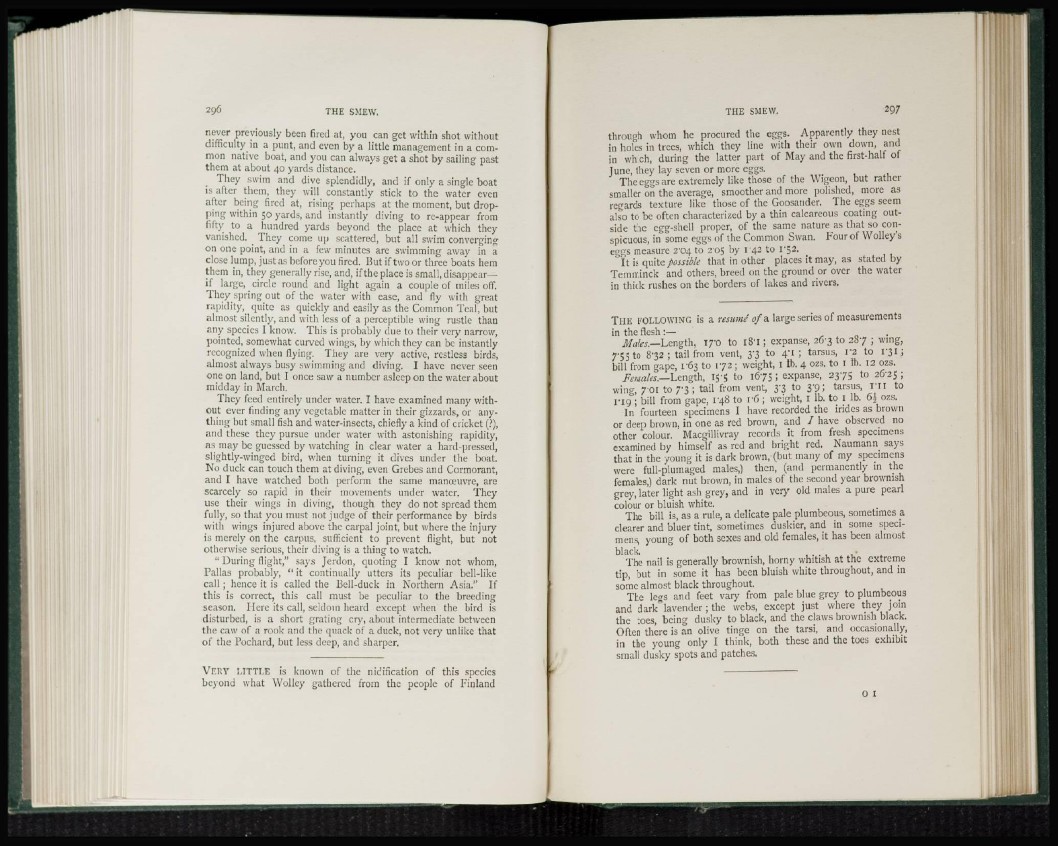
never previously been fired at, you can get within shot without
difficulty in a punt, and even by a little management in a common
native boat, and you can always get a shot by sailing past
them at about 40 yards distance.
They swim and dive splendidly, and if only a single boat
is after them, they will constantly stick to the water even
after being fired at, rising perhaps at the moment, but dropping
within 50 yards, and instantly diving to re-appear from
fifty to a hundred yards beyond the place at which they
vanished. They come up scattered, but all swim converging
on one point, and in a few minutes are swimming away in a
close lump, just as before you fired. But if two or three boats hem
them in, they generally rise, and, if the place is small, disappear—
if large, circle round and light again a couple of miles off.
They spring out of the water with case, and fly with great
rapidity, quite as quickly and easily as the Common Teal, but
almost silently, and with less of a perceptible wing rustle than
any species I know. This is probably due to their very narrow,
pointed, somewhat curved wings, by which they can be instantly
recognized when flying. They are very active, restless birds,
almost always busy swimming and diving. I have never seen
one on land, but I once saw a number asleep on the water about
midday in March.
They feed entirely under water. I have examined many without
ever finding any vegetable matter in their gizzards, or anything
but small fish and water-insects, chiefly a kind of cricket (?),
and these they pursue under water with astonishing rapidity,
as may be guessed by watching in clear water a hard-pressed,
slightly-winged bird, when turning it dives under the boat.
No duck can touch them at diving, even Grebes and Cormorant,
and I have watched both perform the same manoeuvre, are
scarcely so rapid in their movements under water. They
use their wings in diving, though they do not spread them
fully, so that you must not judge of their performance by birds
with wings injured above the carpal joint, but where the injury
is merely on the carpus, sufficient to prevent flight, but not
otherwise serious, their diving is a thing to watch.
" During flight," says Jerdon, quoting I know not whom,
Pallas probably, " it continually utters its peculiar bell-like
call ; hence it is called the Bell-duck in Northern Asia." If
this is correct, this call must be peculiar to the breeding
season. Here its call, seldom heard except when the bird is
disturbed, is a short grating cry, about intermediate between
the caw of a rook and the quack of a duck, not very unlike that
of the Pochard, but less deep, and sharper.
VERY LITTLE is known of the nidification of this species
beyond what VVollcy gathered from the people of Finland
through whom he procured the eggs. Apparently they nest
in holes in trees, which they line with their own down, and
in which, during the latter part of May and the first-half of
June, they lay seven or more eggs.
The eggs are extremely like those of the Wigeon, but rather
smaller on the average, smoother and more polished, more as
regards texture like those of the Goosander. The eggs seem
also to be often characterized by a thin calcareous coating outside
the egg-shell proper, of the same nature as that so conspicuous,
in some eggs of the Common Swan. Four of Wolley's
eggs measure 2-04 to 205 by 142 to 1*52.
It is quite possible that in other places it may, as stated by
Temminck and others, breed on the ground or over the water
in thick rushes on the borders of lakes and rivers.
THE FOLLOWING is a resume of a large series of measurements
in the flesh:—
Males.—Length, 17-0 to 181 ; expanse, 26-3 to 28*7 ; wing,
7*55 to 8'32 ; tail from vent, 3*3 to 4-i ; tarsus, vi to 1*31 ;
bill from gape, 1-63 to 172 ; weight, I lb. 4 ozs. to 1 lb. 12 ozs.
Females.—Length, 15-5 to 1675 ; expanse, 2375 to 26^25 ;
wing, 701 to 7*3 ; tail from vent, 3'3 to 3*9; tarsus, r n to
1-19 ; bill from gape, i-48 to r6 ; weight, 1 lb. to 1 lb. 6£ ozs.
In fourteen specimens I have recorded the irides as brown
or deep brown, in one as red brown, and / have observed no
other colour. Macgillivray records it from fresh specimens
examined by himself as red and bright red. Naumann says
that in the young it is dark brown, (but many of my specimens
were full-plumaged males,) then, (and permanently in the
females,) dark nut brown, in males of the second year brownish
grey, later light ash grey, and in very old males a pure pearl
colour or bluish white.
The bill is, as a rule, a delicate pale plumbeous, sometimes a
clearer and bluer tint, sometimes duskier, and in some specimens,
young of both sexes and old females, it has been almost
black.
The nail is generally brownish, horny whitish at the extreme
tip, but in some it has been bluish white throughout, and in
some almost black throughout.
The legs and feet vary from pale blue grey to plumbeous
and dark lavender; the webs, except just where they join
the toes, being dusky to black, and the claws brownish black.
Often there is an olive tinge on the tarsi, and occasionally,
in the young only I think, both these and the toes exhibit
small dusky spots and patches.
o 1